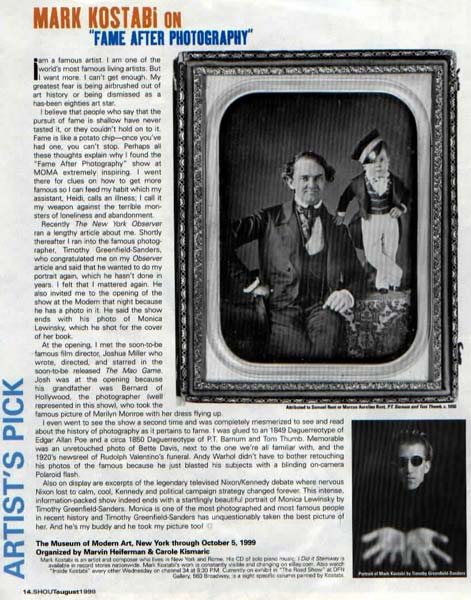Mark Kostabi on “Fame After Photography”

I am a famous artist. I am one of the world’s most famous living artists. But I want more. I can’t get enough. My greatest fear is being airbrushed out of art history or being dismissed as a has-been eighties art star.
I believe that people who say that the pursuit of fame is shallow have never tasted it, or they couldn’t hold on to it. Fame is like a potato chip—once you’ve had one, you can’t stop. Perhaps all these thoughts explain why I found the “Fame After Photography” show at MOMA extremely inspiring. I went there for clues on how to get more famous so I can feed my habit which my assistant, Heidi, calls an illness; I call it my weapon against the terrible monsters of loneliness and abandonment.
Recently The New York Observer ran a lengthy article about me. Shortly thereafter I ran into the famous photographer, Timothy Greenfield-Sanders, who congratulated me on my Observer article and said that he wanted to do my portrait again, which he hasn’t done in years. I felt that I mattered again. He also invited me to the opening of the show at the Modern that night because he has a photo in it. He said the show ends with his photo of Monica Lewinsky, which he shot for the cover of her book.
At the opening, I met the soon-to-be famous film director, Joshua Miller, who wrote, directed, and starred in the soon-to-be released The Mao Game. Josh was at the opening because his grandfather was Bernard of Hollywood, the photographer (well represented in this show), who took the famous picture of Marilyn Monroe with her dress flying up.
I even went to see the show a second time and was completely mesmerized to see and read about the history of photography as it pertains to fame. I was glued to an 1849 Daguerreotype of Edgar Allan Poe and a circa 1850 Daguerreotype of P.T. Barnum and Tom Thumb. Memorable was an unretouched photo of Bette Davis, next to the one we’re all familiar with, and the 1920s newsreel of Rudolph Valentino’s funeral. Andy Warhol didn’t have to bother retouching his photos of the famous because he just blasted his subjects with a blinding on-camera Polaroid flash.
Also on display are excerpts of the legendary televised Nixon/Kennedy debate where nervous Nixon lost to calm, cool, Kennedy and political campaign strategy changed forever. This intense, information-packed show indeed ends with a startlingly beautiful portrait of Monica Lewinsky by Timothy Greenfield-Sanders. Monica is one of the most photographed and most famous people in recent history and Timothy Greenfield-Sanders has unquestionably taken the best picture of her. And he’s my buddy and he took my picture too!
August 1999